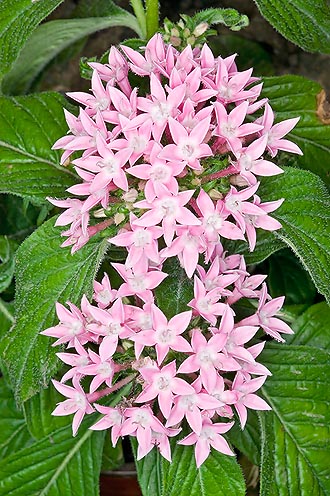Family : Rubiaceae

Text © Pietro Puccio

English translation by Mario Beltramini

Stellate flowers in pink, mauve or white corymbs © Mazza
The Pentas lanceolata (Forssk.) Deflers (1889) is native to Tropical Africa (Burundi, Rwanda, Democratic Republic of the Congo, Djibouti, Ethiopia, Kenya, Tanzania, Uganda, Mozambique), Comoros and the Arabian Peninsula (Saudi Arabia, Yemen).
The name of the genus comes from the Greek “pénte”= five, with reference to the five petals of the flower; the name of the species from the Latin word “lanceola” = lance-shaped, with reference to the shape of its leaves.
Common names: “Egyptian star cluster”, “star cluster”, “star flower” (English); “bouquet d’étoiles” (French); “Sternblume” (German); “penta” (Spanish); “estrela-do-Egito”, “show-de-estrelas”, “cacho-de-estrelas”, “silena” (Portuguese).
Herbaceous perennial plant, tall up to 1,5 m, it shows ovate to lanceolate leaves, pubescent, 8-14 cm long, dark green and with evident veins. The star shaped flowers, with a diameter of 10-15 mm, are united in thick terminal corymbs, usually of pink, mauve or white colours, which are produced, in warm climates, all the year round almost continuously. The fruits are 4-5 mm long capsules. It reproduces by cutting with bottom heat, and by seed, in which case the colour of the flowers can differ from the one of the mother plant; the seeds are to be placed on the surface of the soil at a temperature not lower than 20°C and germinate in 1-2 weeks.
Plant of great ornamental value, to be cultivated preferably in full sun, or light shade, in the tropical and subtropical areas, elsewhere it can be cultivated as an annual, seen its growing speed, or in pot in order to keep it protected in a sheltered location when the temperature drops, roughly, under the 10°C.
It prefers fertile sub-acid, draining, soils, which are to be maintained humid.
Synonyms: Ophiorrhiza lanceolata Forssk. (1775); Manettia lanceolata (Forssk.) Vahl (1790); Mussaenda aegyptiaca Poir. (1797); Neurocarpaea lanceolata (Forssk.) R.Br. (1814); Mussaenda lanceolata (Forssk.) Spreng. (1824); Mussaenda luteola Delile in F.Cailliaud (1827); Pseudomussaenda lanceolata (Forssk.) Wernham, (1916).
→ To appreciate the biodiversity within the RUBIACEAE family please click here.
